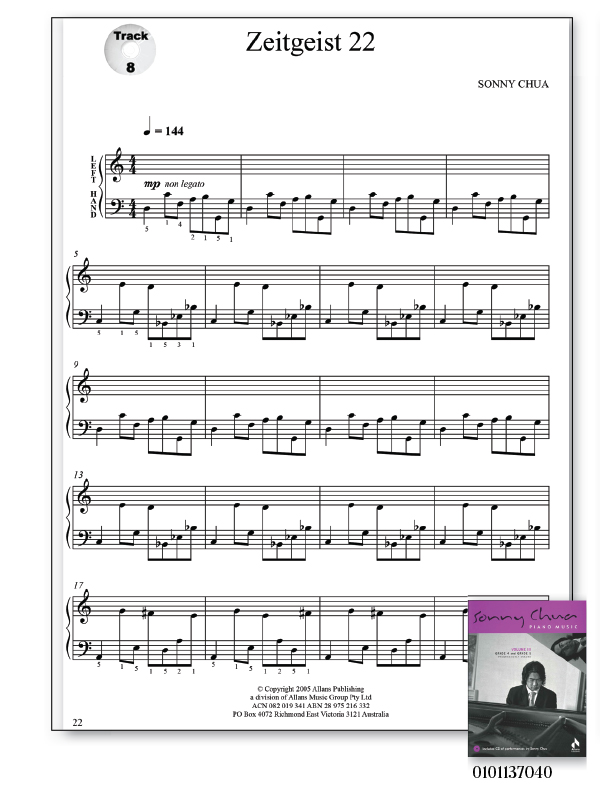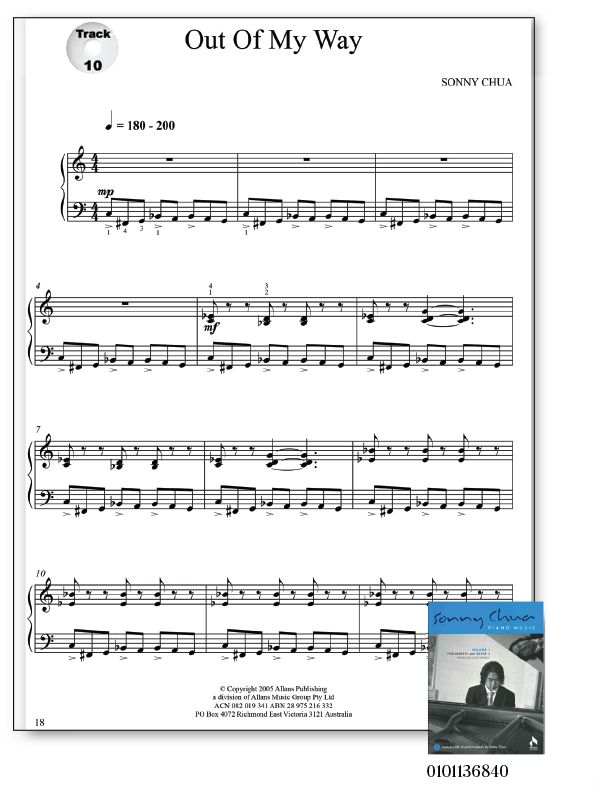Until recently, composer Sonny Chua was merely a name at the top of a few pieces I had taught to students over the years.
However, on a recent trip to Melbourne, I was fortunate to be invited by Gina Wake to dine with Sonny and Dr Jovanni-Rey de Pedro, a performer and presenter I had met at a previous Australasian Piano Pedagogy Conference.
Gina prepared a plethora of scrumptious culinary delights and the four of us chatted the night away. The conversation covered families, everyday life and trying to convince Sonny of the merits of social media. We talked at length about piano, teaching, performance, the passion of composing and the hard work behind the scenes, of which we as teachers only see the end result – publishing … and promoting.

Later, I further investigated Sonny’s music and discovered a treasure trove of works – captivating for students, fun to learn and listen to, despite some of it being available for more than 20 years!
Discovering the music of Sonny Chua
I deliberately made a point of teaching Sonny’s works last year and can quite honestly say that my teaching life took a turn … for the humorous. I practically forced his music into my students’ repertoire – allowing students to choose new pieces by title and they selected works such as T-Rex Asleep, Dog Hungry, It Wasn’t Me, Hoonmobile, Death By Pasta, Rodeo, The 3 Blind Mice in Paris (for four hands), and many more.
“I have never laughed so hard with my students as I did with the ‘Dog’ and ‘T-Rex’ duets.”
The tone of our lessons changed, where fun took over and learning became secondary (in the student’s mind). At student concerts, the pieces were most entertaining for both performer and audience, which resulted in reduced performance anxiety.
At a glance, Sonny’s works can look deceptively simple. They are pattern structured, for example the Zeitgeist titles, the repetition can give a sense of achievement and may have a student (or teacher!) believing it will take less time to complete. However, here is a warning … don’t forget to look at the tempo marking! Suddenly the piece poses a new challenge, working towards a faster tempo; the students often don’t realise that they are honing technique at the same time as learning a fun piece. This particular excerpt from Zeitgeist 22 (approximately Grade 5) is for the left hand only, a very enjoyable challenge as the notes very subtly change order on progression of the piece.
Out of my Way
Sonny’s rhythmic intricacies bring an element of surprise to performers and listeners, expanding horizons of not-so-simple 4/4 time with quavers less commonly arranged in groups of 3-2-3 and 3-3-2, as seen in Out Of My Way (approx. Grade 1).
From a student perspective, positive feedback is my goal and I received this gem verbally from a 13-year-old student having learned Out Of My Way and Dog Awake: “It’s fun, groovy music … challenging but not so much that it’s not still fun. Exposes weaknesses, works fingers hard and individually challenges each finger. Rhythmically unpredictable and very interesting.”
I received smiles almost unanimously. The quirky titles establish the mood for the pieces and the sounds Chua shapes in his music aptly describe the titles. The space left for experimentation had students analysing their sound and ultimately establishing ownership of the music. As we know, once a performer owns a piece, satisfaction and enjoyment overflows.
Midnight Snack was my first experience of Sonny’s music, and I loved it for its quirky nature and descriptive title. It portrays tip-toeing through a sleeping house, with tones of midnight darkness producing an eerie air. The 7/8 time signature brings unease, which keeps the listener on edge. The piece demands attention to detail, technical ability, discipline and concentration; to the point where the storyline may suffer if omitted. This is consistent across many of Sonny’s works.
Stop That!
I performed Stop That!, based on chopsticks, at a student concert. The usual wince that ensues when hearing the theme became something parents at the concert could identify with. They seemed to love the irreverence of the piece; the inserted dissonance, the spoken “cha cha cha” and the written option in the end notes that I chose to do – “play with fist if so inclined” – combining to create a wonderful spoof.
Following the privilege of sharing a meal with Sonny, I have a heightened personal respect for his incredible musical insights, passion for teaching, devotion to family and holding fast to life values while juggling the stresses and demands of teaching, performing and composing.
Approaching Sonny’s Music
When approaching Sonny’s music, I have come to expect the unexpected, to be prepared to laugh at the playfulness woven into his pieces, and be on the lookout for the quirky recognisable melodies hidden within an altered chord structure. His diverse selection of works provides options from preliminary through to diploma level standards.
Now that I know him as more than just a name on paper, it is a real buzz to be able to ask Sonny questions relating to his music. When one of my students had a query about her piece, I asked Sonny via social media and receiving a prompt answer certainly brought a great smile of delight to my student for the duration of the next scheduled lesson!
The reality of playing music that the composer knows you’re playing is inspiring for students – and very cool for teachers. The bonus to purchasing particularly the Piano Music Volumes books is that they include audio recordings of each piece, performed superbly by Sonny himself. Enjoy the journey!



